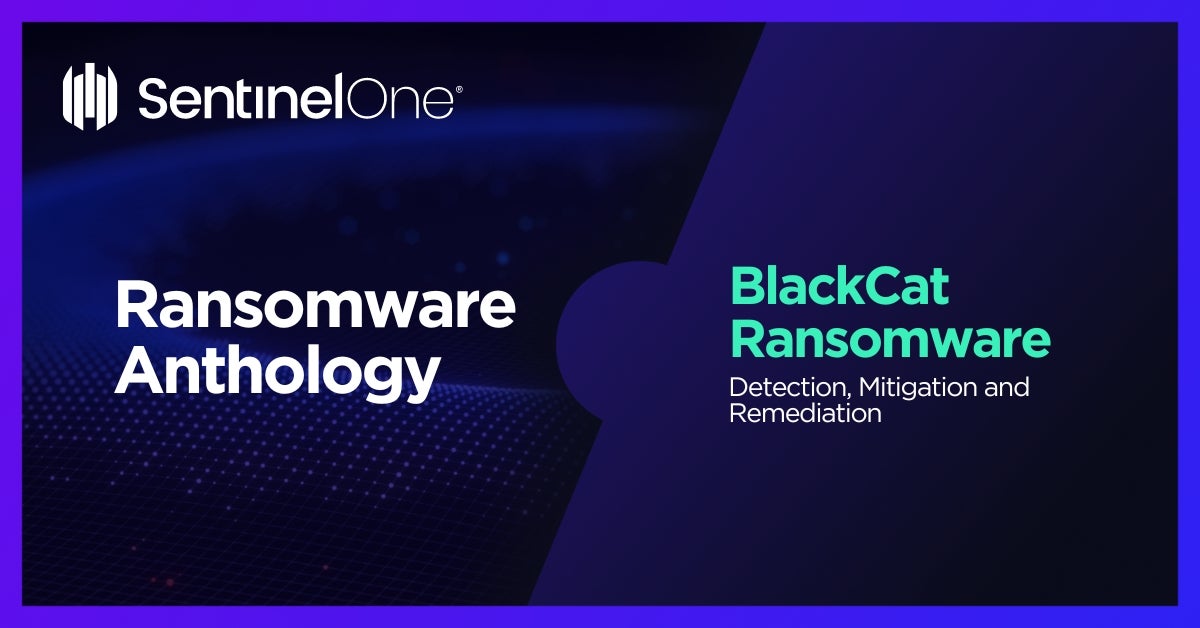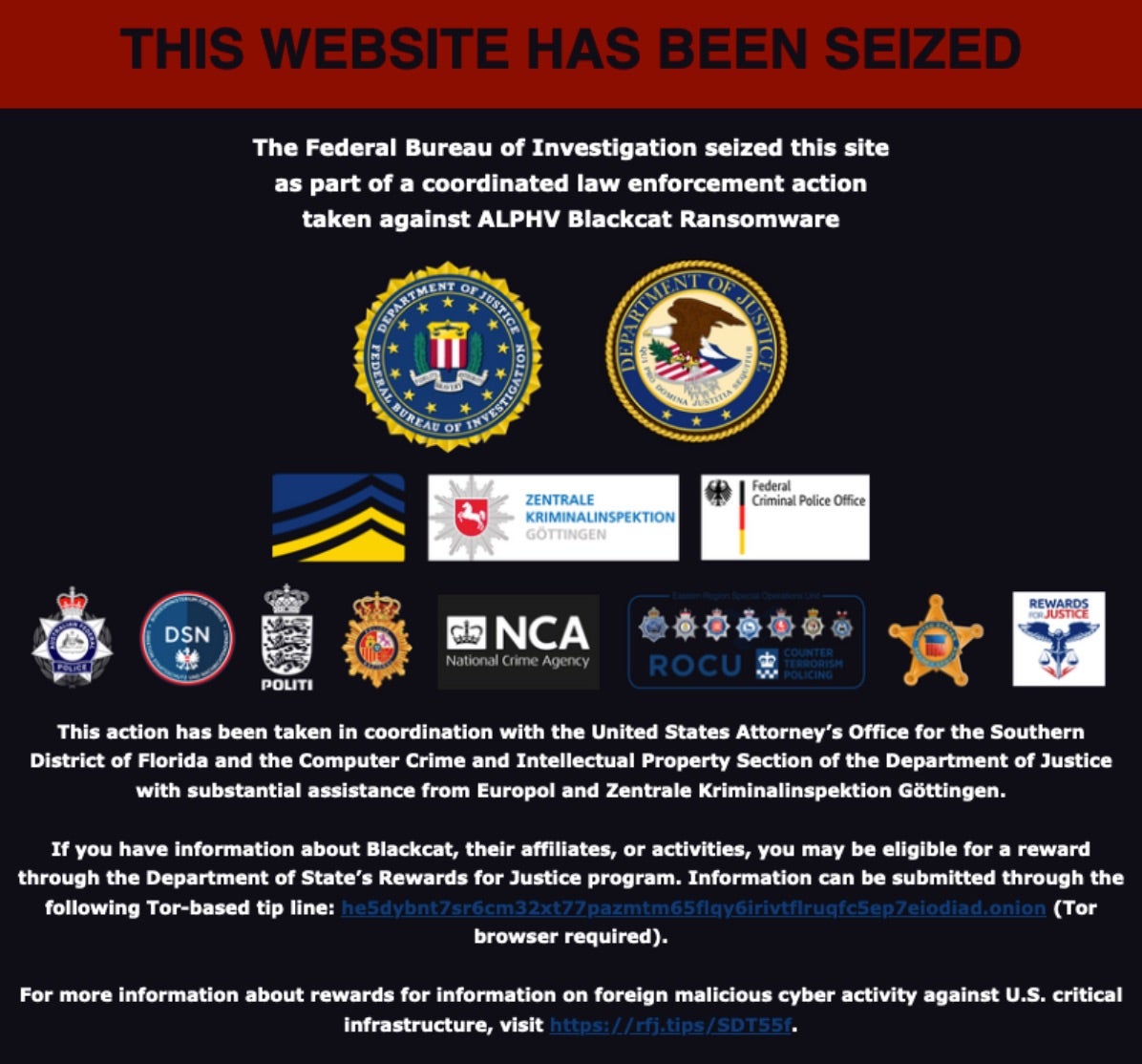BlackCat Ransomware: In-Depth Analysis, Detection, Mitigation, and Removal
Summary of BlackCat/ALPHV Ransomware
BlackCat, also known as AlphaVM and ALPHV, is a Ransomware-as-a-Service (RaaS) that has payloads written in the Rust language. The ransomware family first emerged in late 2021. BlackCat is among the few pieces of malware that use Rust, a popular programming language that works on multiple platforms (Windows and Linux). It targets corporate networks and attempts to extort money by demanding payment for decryption tools and for not releasing any stolen data.
December 19, 2023 Update: The FBI and Office of Public Affairs has publicly announced the seizure and disruption of BlackCat/ALPHV ransomware operations. Along with this announcement, decryption tools have been made available to all victims of BlackCat/ALPHV ransomware operations. Victims of BlackCat ransomware are strongly encouraged to contact their FBI field office for further information and to determine next steps and options for assistance.

What Does BlackCat Ransomware Target?
BlackCat ransomware typically targets the healthcare, finance, government, and education industries. Targeting can vary by operator. Targeting within the CIS (Commonwealth of Independant States) is discouraged.
As of the news of the FBI disruption, primary BlackCat/ALPHV operations are dormant.

How Does BlackCat Ransomware Spread?
BlackCat is delivered via Cobalt Strike or similar framework. Operators of BlackCat leverage LOLBins and customized scripts for lateral movement and environment reconnaissance and discovery.
BlackCat Ransomware Technical Details
BlackCat supports both Windows and Linux operating systems. Samples analyzed to date require an “access token” to be supplied as a parameter upon execution. This is similar to threats like Egregorand is often used as an anti-analysis tactic. In addition, BlackCat on Windows will attempt to delete VSS (Volume Shadow Copies) as well as enumerate local drives to encrypt eligible files. Infected users are instructed to connect to the attackers’ payment portal via TOR.
BlackCat samples are full-featured and include multiple privilege escalation methods (on Windows). Built-in methods include UAC_Bypass (T1550.002 ), and Masquerade_PEB (T1036.004). BlackCat payloads are capable of discovering and propagating to remote (and accessible) hosts via psexec.exe.(S0029).
The ALPHV threat group has quickly adopted extortion tactics, such as threatening victims with DDoS attacks, leaking stolen data, and intimidating employees and customers if ransom is not paid. Additionally, the group has been one of the first to support intermittent encryption modes.
How to Detect BlackCat Ransomware
- The SentinelOne Singularity XDR Platform can identify and stop any malicious activities and items related to BlackCat.
In case you do not have SentinelOne deployed, detecting this ransomware requires a combination of technical and operational measures, which are designed to identify and flag suspicious activity on the network. This allows the organization to take appropriate action, and to prevent or mitigate the impact of the ransomware attack.
- Use antimalware software, or other security tools, which are capable of detecting and blocking known ransomware variants. These tools may use signatures, heuristics, or machine learning algorithms, to identify and block suspicious files or activities.
- Monitor network traffic, and look for indicators of compromise, such as unusual network traffic patterns, or communication with known command-and-control servers.
- Conduct regular security audits and assessments, to identify vulnerabilities in the network and the system, and to ensure that all security controls are in place and functioning properly.
- Educate and train employees on cybersecurity best practices, including how to identify and report suspicious emails, or other threats.
- Implement a robust backup and recovery plan, to ensure that the organization has a copy of its data, and can restore it in case of an attack.
How to Mitigate BlackCat Ransomware
- The SentinelOne Singularity XDR Platform can return systems to their original state using either the Repair or Rollback feature.
If you do not have SentinelOne deployed, there are several steps that organizations can take to mitigate the risk of BlackCat ransomware attacks.
Educate Employees
Employees should be educated on the risks of ransomware, and on how to identify and avoid phishing emails, malicious attachments, and other threats. They should be encouraged to report suspicious emails or attachments, and to avoid opening them, or clicking on links or buttons in them.
Implement Strong Passwords
Organizations should implement strong, unique passwords for all user accounts, and should regularly update and rotate these passwords. Passwords should be at least 8 characters long, and should include a combination of uppercase and lowercase letters, numbers, and special characters.
Enable Multi-factor Authentication
Organizations should enable multi-factor authentication (MFA) for all user accounts, to provide an additional layer of security. This can be done through the use of mobile apps, such as Google Authenticator or Microsoft Authenticator, or through the use of physical tokens or smart cards.
Update and Patch Systems
Organizations should regularly update and patch their systems, to fix any known vulnerabilities, and to prevent attackers from exploiting them. This includes updating the operating system, applications, and firmware on all devices, as well as disabling any unnecessary or unused services or protocols.
Implement Backup and Disaster Recovery
Organizations should implement regular backup and disaster recovery (BDR) processes, to ensure that they can recover from ransomware attacks, or other disasters. This includes creating regular backups of all data and systems, and storing these backups in a secure, offsite location.
The backups should be tested regularly, to ensure that they are working, and that they can be restored quickly and easily.
BlackCat Ransomware FAQs
What is BlackCat (ALPHV) ransomware?
BlackCat is a modern ransomware family that first appeared in November 2021. It’s a Ransomware-as-a-Service (RaaS) operation where developers provide the malware to affiliates who conduct attacks. When BlackCat hits your systems, it encrypts your files and demands payment for decryption. They will also steal your data before encryption and threaten to publish it if you don’t pay.
What programming language is BlackCat ransomware written in?
BlackCat ransomware is written in Rust. This makes it different from most other ransomware types. Using Rust gives BlackCat better performance and security protections. It helps the ransomware run on different operating systems. The code is harder to analyze for security researchers. You can see BlackCat’s advanced capabilities because of this programming language choice.
What encryption algorithms does BlackCat ransomware use?
BlackCat ransomware uses multiple strong encryption algorithms to lock your files. They will encrypt your data using ChaCha20 for file content encryption and RSA for key encryption. Sometimes they use AES-256 as well. These algorithms are highly secure, and you cannot break them with current technology. Once your files are encrypted, you will need the specific decryption key to recover them.
What file extensions are associated with BlackCat ransomware infections?
When BlackCat ransomware encrypts your files, it adds specific extensions to them. You will see extensions like .alphv, .onion, or random strings of characters. Some attacks use custom extensions specified by the attackers. If you notice these strange extensions suddenly appearing on your files, you should immediately disconnect that system from your network.
Does BlackCat ransomware target both Windows and Linux systems?
Yes, BlackCat ransomware targets both Windows and Linux systems. It’s one of the more versatile ransomware families. They will attack Windows workstations, servers, and Linux-based servers, including VMware ESXi hosts. You should protect all your systems regardless of operating system. The attackers will look for any vulnerable system they can find in your network.
How does BlackCat ransomware gain initial access to networks?
BlackCat operators gain initial access through several methods. They will exploit vulnerable public-facing applications and use stolen credentials. Remote Desktop Protocol (RDP) and VPN services are common entry points. If you have unpatched systems or weak passwords, they will find and use them. Compromised service providers and supply chain weaknesses are also used to get into your networks.
What are common delivery methods for BlackCat ransomware payloads?
BlackCat ransomware is commonly delivered through phishing emails with malicious attachments. They will use RDP and VPN compromises to directly deploy their malware. Sometimes they leverage other malware like Qakbot or SystemBC as initial access. You might also see them using compromised service providers to reach your network. Once inside, they move laterally to spread their payload.
What are the indicators of compromise (IOCs) for BlackCat ransomware?
You can identify BlackCat ransomware by looking for specific signs. The ransom note is usually named “RECOVER-FILES.txt” or something similar. They will disable volume shadow copies using commands like “vssadmin delete shadows”. You should monitor for unusual PowerShell activity, new scheduled tasks, and unexpected network connections. File extensions changed to .alphv are a clear indicator.
Are endpoint detection and response (EDR) tools effective against BlackCat?
Yes, modern EDR tools can be effective against BlackCat ransomware. They will detect the unusual behaviors and file activities that happen during an attack. You should make sure your EDR solution is properly configured and monitored. If your EDR identifies suspicious activity, it can block the malware before full encryption occurs. You need to keep these tools updated with the latest threat intelligence.
